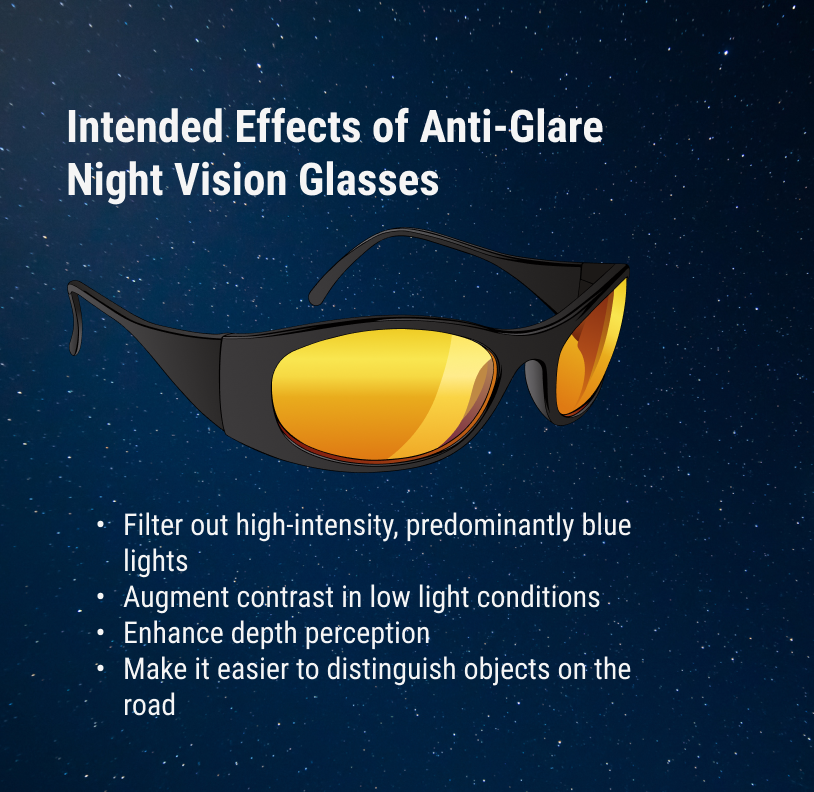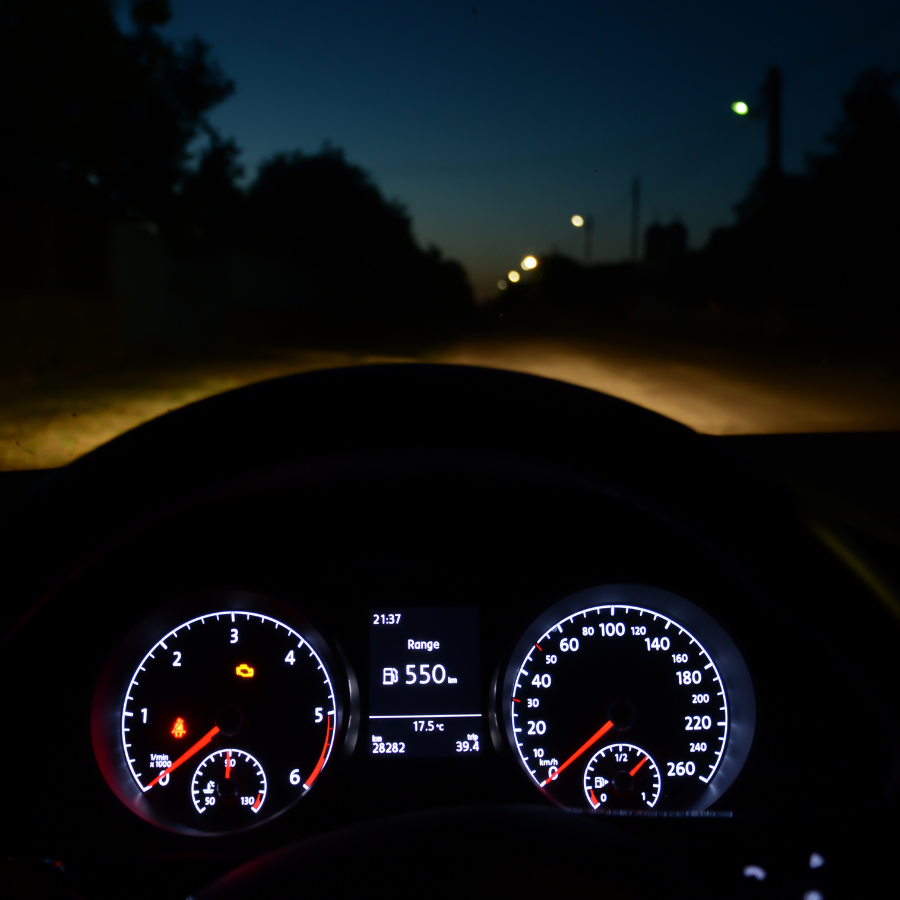Do Night Driving Glasses Work
Night driving can be a demanding task, with trailing headlight glare, oncoming traffic, and limited light posing significant challenges. One solution that has been marketed for these issues is night driving glasses. These are special glasses, often featuring distinctive yellow lenses, that claim to reduce glare and improve contrast, making it easier to see when driving after dusk. Yet, an important question still stands: Do night driving glasses really work? Unfortunately, this simple question does not necessarily have a simple answer.
At Visionary Eye Doctors, we are a specialized team dedicated to providing stellar eye care tailored to individual needs and lifestyle goals. We strive to ensure your visual health and overall well-being are optimal. Our extensive expertise and utilizing the most advanced technology give us a unique perspective on eye-related matters, including the effectiveness of night driving glasses.
The following sections of this blog will illuminate how night-driving glasses function and evaluate their effectiveness based on available research. Our goal is to empower you to make informed decisions, navigating through diverse opinions and scientific studies regarding night-driving glasses.
Stay tuned as we delve into the science and research surrounding night driving glasses and their claims of enhancing your night vision and overall driving experience.
Understanding Night Driving
Let’s start by acknowledging the fundamental challenges that come with driving at night. It’s an entirely different ballpark compared to daylight conditions. Nighttime conditions are notably less optimal and there are specific issues that tend to arise only after the sun sets.
Night driving issues usually stem from external factors and personal eye health situations. Certainly, the blinding glare from oncoming headlights is one primary concern. Harsh lights from oncoming traffic easily disrupt your vision. The attack of bright lights against a predominantly dark backdrop can momentarily throw off your focus, causing a potential threat to your driving safety.
Moreover, the lack of adequate street light might cause poor peripheral vision. Add to that, the yellow hue from sodium-vapor lamps, predominantly used for street lighting, presents a unique challenge to discern obstacles on the road.
Now, let’s consider the inner workings of our eyes. Some individuals might experience night blindness, a condition that makes it difficult to see in low-light conditions. Factors that contribute to night blindness include inadequate adaptation to darkness, refractive error, and certain medical conditions, such as retinitis pigmentosa.
Furthermore, depth perception, an important aspect of safe driving, often gets compromised at night. Accurately judging the distance and speed of other vehicles becomes challenging in low-light conditions. This, coupled with eye strain and occasionally blurry vision from continuously adjusting to shifting light sources, makes night driving a strenuous task.
On top of these challenges, we must also consider blue light. Present in daylight and some artificial lighting, blue light scatters more easily than other visible light. This scattering makes objects appear less sharp and can contribute to glare, particularly in the context of oncoming headlights.
Getting a handle on night driving, with its myriad of challenges, is certainly not a walk in the park. It is in this context that night-driving glasses have been introduced to the market as a potential solution. In the next section, we’ll explore how night-driving glasses aim to counter these issues.
 The Mechanism of Night Driving Glasses
The Mechanism of Night Driving Glasses
Having established the issues associated with night driving, let’s shift our focus to the proposed solution: night-driving glasses. These specialized glasses often come with yellow-tinted lenses and claim to enhance visibility in dim environments. So how do these components function together to allegedly offer a better night driving experience?
A key feature of night driving glasses is the yellow tint on the lenses. The yellow tint is designed to filter out high-intensity, predominantly blue lights, by softening harsh lights and reducing the resultant glare. This blue light reduction can help decrease eye strain and improve general comfort when driving at night. Yellow-tinted glasses also aim to augment contrast in low light conditions, potentially enhancing depth perception and making it easier to distinguish objects on the road.
On the other hand, some night glasses come with clear lenses treated with anti-reflective coating, commonly referred to as ‘AR coating’. This coating is designed to minimize disruptive reflections on the lens surface, especially from oncoming headlights. With reduced reflections, drivers might find it more relaxed on their eyes, leading to a less stressful driving experience.
Whether they come with yellow-tinted lenses or clear lenses with AR coating, night driving glasses are available in both prescription and non-prescription versions. If you require corrective lenses for a refractive error, you can have your prescription incorporated into the design of night-driving glasses. Users who don’t need corrective lenses can opt for non-prescription glasses.
But does combining these elements in a specialized pair of glasses undoubtedly improve your vision when driving at night? After understanding the mechanism, it’s only logical to question its effectiveness. In our next section, we will evaluate the available research and studies concerning the performance of night driving glasses.
Evaluating the Effectiveness of Night Driving Glasses
With an understanding of how night driving glasses are designed to function, the next step is to assess the effectiveness of these glasses through various research studies and visual tests.
It’s important to note that despite their popularity, results from scientific investigations about their effectiveness are inconsistent. Some studies suggest night driving glasses can, indeed, help reduce glare and eye strain, making it more comfortable for individuals driving in low-light conditions. For instance, a certain fraction of trials demonstrate that these glasses can prevent temporary visual impairment caused by the bright light from oncoming headlights. This effect can translate to a better continuation of vision against such harsh light sources.
However, other researchers argue that the yellow-tinted lenses can potentially decrease visual acuity, especially in very low light conditions. Lenses with yellow or amber tints may improve contrast because they block scattered, blue light. Yet, they do so at a cost – the same tint also blocks some useful light, reducing overall light transmission to the eye. This reduction can potentially make your surroundings seem even darker, compromising visual clarity.
Lastly, the effectiveness of night driving glasses is also impacted by individual factors. For instance, refractive errors, if any, should be corrected with prescription lenses in night driving glasses for optimal performance. UV protection is another consideration. All eyewear, including night driving glasses, should block 100% of both UVA and UVB rays. High-energy visible (HEV) light produced by electronics and energy-efficient lightbulbs may be blocked with specially designed lenses for added protection.
In essence, the effectiveness of night driving glasses isn’t quite cut and dry; the answer lies somewhere in between, with ongoing studies and research aiming to provide a more definitive stance. To fully comprehend the potential benefits and limitations of these glasses, we recommend an in-person consultation with an eye specialist.
Recommendations from Visionary Eye Doctors
Night driving glasses have created quite a buzz with their claims of reducing glare and eye strain, and improving night vision. Their mechanism and components suggest progress towards a more comfortable night driving experience. However, the question, “Do night driving glasses work?” isn’t answered straightforwardly. While some studies and visual tests favor their usage, others highlight potential drawbacks and inefficiencies.
It’s important to remember that one size doesn’t fit all when it comes to visual health. What’s effective for one person might not be for another. Given the fluctuating evidence around the effectiveness of night driving glasses, it would be unwise to take them as a failsafe solution for night driving challenges.
If night driving is a concern for you, the best course of action would be to consult with your trusted eye doctor.
Visionary Eye Doctors, for instance, could provide you with a personalized solution, considering your age, medical history, visual acuity, and refractive error, among other factors.
In the realm of vision, a direct examination coupled with professional advice is steps ahead of a general product claiming universal effectiveness. Our team at Visionary Eye Doctors is readily available to provide thorough eye examinations and honest recommendations, giving you the long-term comfort you deserve while driving.
The promise of night driving glasses is indeed fascinating, but it’s crucial to approach it with informed judgment. Remember, your vision is not just about seeing the world but also about interacting with it safely. So, no matter where the road takes you at twilight, let it be a journey secured with accurate, reliable, and customized solutions for your eye health. Here at Visionary Eye Doctors, we care about your vision because we understand how it shapes your perception of the world.




